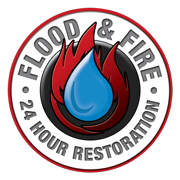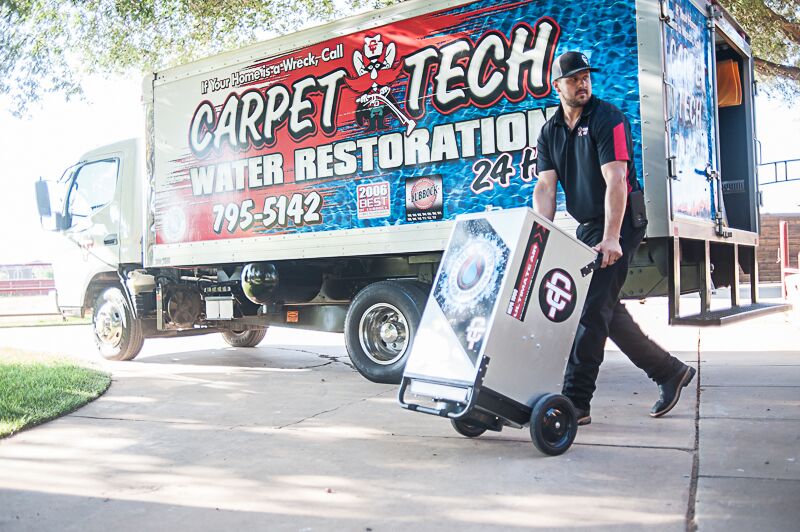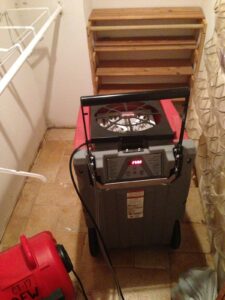
Wood floor water damage is an all-too-common problem faced by homeowners. It is a form of damage that develops from prolonged exposure of wood floors to water or excessive moisture. This could arise due to a plethora of reasons, such as a burst pipe, a leaking roof, a water leak in the plumbing, or merely a window left open during a rainstorm. These possibilities show just how vulnerable hardwood flooring can be to a range of possible issues.
The damaging effects of excess water are not always visibly apparent, making it critical to regularly monitor and maintain your wood flooring. On hardwood floors, excess moisture can cause a host of problems such as warping, discoloration, or even rot – compromising the structural integrity of the flooring. When left untreated, high moisture content can not only weaken the wood but could also create a conducive environment for mold and fungi to thrive.
This is where Carpet Tech – a leader in water, flood, and mold restoration – steps in. Our team of professionals are not just experts in identifying, repairing, and restoring wood flooring from water damage but are also committed to providing a speedy, comprehensive, and efficient service suited to your needs. Our experience and expertise in water damage restoration make us the perfect fit to tackle your flooring damage woes.
When it comes to wood floor water damage, it is far better to be proactive. By identifying the signs early on, you can work to quickly curb the damage before it escalates. With the right guidance from professionals, a thorough understanding of the damages, and an immediate action plan, you can safeguard and extend the life of your wood flooring. That’s precisely what we at Carpet Tech aim to help you achieve – a healthy, safe, and long-lasting wood floor.

Recognizing Water Damage on Wood Floors
 Spotting the signs of water damage on wood flooring early could be the difference between a minor fix and a significant restoration project. Learning to identify these signs is an essential part of effective maintenance and prevention.
Spotting the signs of water damage on wood flooring early could be the difference between a minor fix and a significant restoration project. Learning to identify these signs is an essential part of effective maintenance and prevention.
Often, water damage manifests in physical changes in the wood floors. This could be anything from subtle discoloration to more noticeable cupping or even warping of the floorboards – a sure sign of excess moisture. Sometimes, the wooden floor may develop a musty smell, especially in cases of water leaks. This unmistakable odor could indicate hidden water damage and potential mold growth.
The moisture content in your flooring plays a significant role in this damage. The percentage of moisture in the air can directly affect the amount of moisture in the wood, causing sudden or gradual changes. If a hardwood floor absorbs an excessive amount of moisture from the air or water leak, it could lead to visible and structural damage. Conversely, if the moisture level is too low, the wood can dry out, become brittle, and crack.
To accurately assess the severity of water damage on your wooden flooring, make use of a moisture meter. This handy device can detect the specific moisture content level in the affected area of the floor. It provides insights into whether the intrusion of water has led to destructive levels of dampness within the wood flooring.
It’s important to note that not all water damage results from immediate disasters or mishaps. Sometimes, slower leaks, like plumbing issues or even high levels of humidity, can lead to significant problems over time. This is why regular inspections and prompt action on identified issues are paramount to preventing further damage.
Ramifications of untreated water damage range from various aesthetic issues to health hazards from mold and mildew. Even worse, it poses long-term structural complications that can become troublesome if not addressed swiftly.
Effective Measures to Tackle Wood Floor Water Damage
After identifying water damage on your wood flooring, quick and effective action becomes imperative to prevent permanent damage and potential mold growth. The sooner you address the issue, the better the outcome will be. Here are some immediate first steps you can take to mitigate the effects of water damage:
Before you begin, document everything for insurance purposes. This includes taking pictures of the affected area and making any necessary notes about the damage. Then, you’re ready to kick-start the remediation process.
First and foremost, stop the source of the leak. Identify where the water is coming from and make sure you put an end to it. This might mean closing a window, fixing a pipe, or calling in a professional to handle more complex issues.
Next, remove standing water and excess moisture from the area. A wet vacuum, or shop vacuum, can be your best friend in this process. These machines are designed to remove surface water and even some moisture within the wood itself. Remember, the goal here is to get rid of as much excess water as possible.
Post-water extraction and effective and efficient drying are crucial. Employ the use of fans, dehumidifiers, heaters, or specially designed air movers to speed up the drying process. This will help reduce the chances of swelling, warping, and buckling of the floorboards.
In addition to these, cleaning the area with mild detergent will help prevent mold and mildew. Use a soft, moist cloth or a soft brush to gently clean the surface. Avoid using harsh chemicals, as they can potentially cause further damage to the wood.
Finally, monitor the process. It’s important to keep a close eye on the affected area to determine if the drying process is working and ensure that moisture levels are reducing. If after a few days, things aren’t improving, it’s probably time to call in a professional.
It’s important to note that some levels of water damage might be too significant for the DIY treatment. If your wooden floor has severe damage or the affected area is larger than what you can handle alone, it’s time to contact a professional restoration company, like Carpet Tech.
When to Contact a Restoration Professional: Carpet Tech to the Rescue

While minor water damage can often be remedied with swift, DIY action, major incidents might require professional help. If the extent of the damage goes beyond just the surface and seeps into more substantial parts of your wooden floor, this is a clear indication of serious water damage. Similarly, if a large area is affected, or if you notice persistent dampness despite your best efforts to dry it out, it’s time to call in the professionals. Signs of mold growth, prolonged water exposure, or significant structural damage to the “wooden flooring” or the “entire floor” further emphasize the need for professional restoration services.
That’s where Carpet Tech comes into the picture. Our team is skilled and IICRC certified, ensuring that we maintain the gold standards in water damage restoration. Our approach to tackling your water damage scenario is comprehensive – we count our job done, not just when we fix the immediate issue but when we restore peace, safety, and the certainty of a well-done job in your home.
Our restoration procedure starts with a thorough inspection of the water-damaged floors. We assess the extent of the damage and develop a strategic restoration plan that is best suited to your home’s specific needs. With transparency at the forefront, we provide clear, detailed estimates for the restoration work, aligning cost efficiency with industry standards.
Whether it’s repairing the water-damaged hardwood floors, removing and replacing severely damaged sections, or restoring the entire floor, we are equipped to handle a range of restoration challenges. At the end of our task, we ensure a complete walkthrough with you to make certain that every issue has been addressed and no room for subsequent problems is left unchecked.
Understanding Insurance Coverage for Water Damage Restoration
Navigating the world of insurance claims following severe water damage to your wood floors can often be a daunting and confusing process. However, it’s an essential part of restoration and recovery. Fortunately, most homeowners insurance policies typically cover sudden and accidental water damage, which includes issues arising from a burst pipe or a severe water leak. However, specifics can greatly depend on your individual policy and the insurance company.
To ensure a smooth handling of the claim, it’s crucial to have a clear understanding of your policy. Understanding what is covered and what is not will help you utilize your coverage effectively. Always remember, that the earlier the claim is filed, the faster your restoration process can begin.
 At Carpet Tech, we prioritize alleviating some of your burden by working directly with your insurance company. From the moment our team arrives, we meticulously document the damage through photos, videos, and detailed notes, kickstarting an immediate documentation process.
At Carpet Tech, we prioritize alleviating some of your burden by working directly with your insurance company. From the moment our team arrives, we meticulously document the damage through photos, videos, and detailed notes, kickstarting an immediate documentation process.
Instead of leaving you to navigate the time-consuming communication with your insurance adjuster, we handle that for you. Our longstanding relationships with various insurance companies facilitate timely and effective conversations about repair scopes and estimates.
All our estimates for restoration work adhere to industry standards and are transparent and concise. We ensure that you are always in the loop, and there are no surprises when your insurance company reviews the claim or when the bill arrives.
Finally, when restoration is complete, we’ll review the work alongside the insurance claim to ensure all aspects are addressed. Should there be any additional concerns from the insurance company, we promptly address them, so you have one less worry to think about.
At Carpet Tech, our ultimate goal is to guide you through the restoration process smoothly. We aim to restore not just your water-damaged wooden floors but also your peace of mind. So, if you’re dealing with the after-effects of a flood or water leak or simply need expert advice to protect or restore your wood flooring, remember, we’re just a call away.

